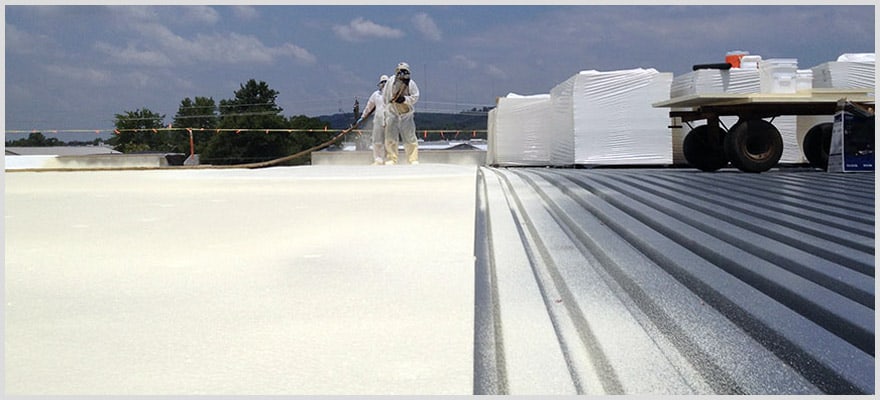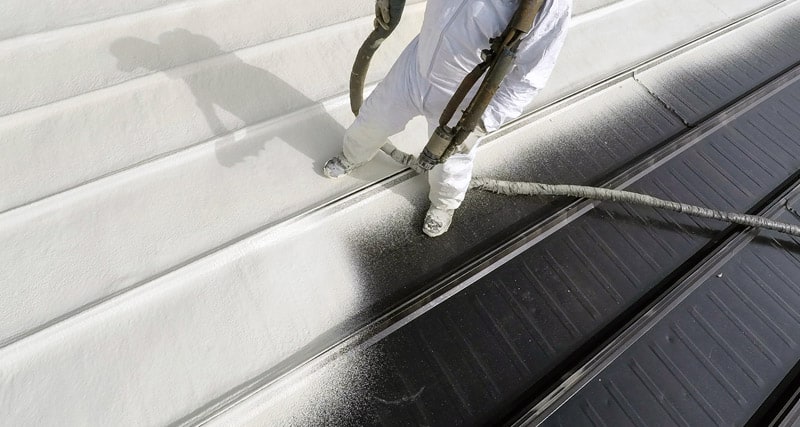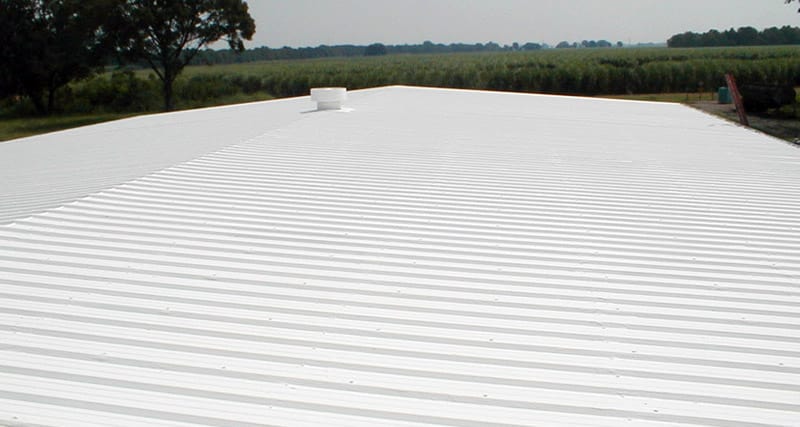The best interiors, the strongest exterior, expensive furniture and the same plain, white roof? There are certainly many alternatives to roofing types than you can imagine.

I know, I know. It can be tough to choose the right one from the different types of flat roofing materials for your house.
Quick Summary – Spray Foam Roofing Pros and Cons:
Pros: Very good insulation, energy efficient, easy to install and maintain, waterproof, versatile and relatively low-cost.
Cons: Need to find a good contractor, must be inspected 1-2 times per year, repairs must be made by an experienced contractor.
If you want the roof of your house to be strong, durable and also to be insulated and water-resistant then we know what the solution is!
The way to go is Spray Foam roofing (SPF). So, the question arises: what it really is? And, what are its various pros and cons?
Once you know these, you will be in a better position to make the right decision. So read along to find out how it’ll really help you.
What is Spray Foam as Roofing Material?
Spray Foam roofing or Spray Polyurethane Foam (SPF) roofing is a technique of building construction (walls or roofs) by using Spray Polyurethane Foam.
SPF is a type of plastic that goes from liquid to solid in a matter of seconds that increases in volume by approximately 30 times as it dries. It is one of the most cost-effective and sustainable roofing, insulation and waterproofing system available today.
SPF-based roof systems are constructed by mixing and spraying a two-component liquid that forms the base of an adhered roof system.
The SPF can be installed in various thicknesses, as per the customer’s needs, to provide slope to drain or meet a specified thermal resistance (scientifically called R-value). A protective surfacing is then applied to the foam to provide protection from the elements.
The first component of the SPF-based roof system is the rigid, closed cell, spray polyurethane foam insulation. This foam comprises of two components, namely, isocyanate and polyol. The components are mixed at the spray gun, which is used to apply them to a substrate.
The second component which is the protective surfacing typically is a spray applied elastomeric coating (though hand and power rollers can be used as alternatives).
The purpose of this surfacing is to provide weather-proofing, protect the foam from UV exposure, provide protection from mechanical damage and assist with the fire-resistant characteristic of the roof system.
Now that you’re aware of what the Spray Foam roofing is, both generally and technically, you must read on to find out the various pros and cons of the roofing system that will help you in deciding your roofing system!
Advantages of Spray Foam Roofing
Easy installation:
Applying Spray Foam is easy. You can apply it on all types of surfaces without disturbing the owner of the house or the commercial property operation.

Easy maintenance:
Not only is it easy to install but also, once it is installed it requires minimal upkeep and if properly maintained it can last for over 50 years. Even if one needs silicon re-coating, there’s no tear off of the existing roof, he or she can apply the new coat on top of it to make it new all over again.
Energy efficient:
It has great insulation and acts as a barrier for heat, air, and moisture. It keeps heat out in the summers and is warmer during winter that helps in lowering the energy costs for the property or commercial real estate building.
Versatile:
You can change the look of the physical appearance of the roof as per your needs. The texture could be soft or semi-rigid or even high-density.
Disadvantages of Spray Foam Insulation

Hard to find the right contractor:
It is difficult to find the right contractor to do the application of the roofing system as not all contractors have the technical knowledge and understanding to install the roofing properly.
Cannot apply in all weather conditions:
The spray Foam roofing can only be installed in specific weather conditions. One cannot perform it when it’s snowing or when there is moisture or visible dampness on the existing roof. This does not mean that this insulation is not good in cold weather etc. You just need to apply it when the weather allows you (e.g in summer months for example).
Proper checks needed every six months:
You might have to take care of this roofing system, frequently.
The final word for you to take away is that Spray foam roofing is rapidly becoming the go-to roofing system for commercial, industrial and all sorts of facilities so if you’re the one thinking over it, you’ve just got your answer as to why it is one of the best options in certain cases.
How Long Does Spray Foam Roofing Last?
The longevity of your spray foam roofing depends greatly on certain things like its maintenance and climate to name a couple.
There is no exact answer to this question mainly because the concept of spray foam roofing is relatively new. This material type has only been around for about 5o years, so putting a time frame on something that is affected by external factors can be quite difficult.
However, there are some expected times for this type of roofing depending on external factors, like the elements, climate, maintenance, and even the traffic on to the roof.
An original spray on to a new roof is said to last anywhere from 25 to 35 years. If you go in and clean the spray foam roofing as part of the maintenance and re-apply it, you essentially have a brand new roof; this will add another 20 to 35 years, making the total lifespan of your roof up to 70 years long which is an excellent time frame in terms of roofing.
As we have mentioned above, the system of spray roofing hasn’t been around long enough for us to know how long it will last. Still, since its introduction, there have been many significant improvements to the materials and method, hence making it a lot more reliable.
Spray Foam Roofing Cost
Of course, the cost of your spray foam roofing depends on a number of different factors. The factors include things like the slope and pitch of your roof, and the size of your roof as well, plus where you are getting your roofing done from.
On average, the cost of spray foam roofing is anywhere between $6,000 and $7,500, taking into account the variations mentioned above. Also, the thickness of the SPF material plays a significant role in cost.
What you can expect to pay on average is between $1.70 and $2.50 per square foot (for a typical SPF roofing of 1.5 inch layer of foam, including material and labor cost).
However the prices will vary according to the contractor you use for the job. This cost includes the cost of materials and labor.
Of course, there are many other things that come into play while you are looking at the cost of installation. The condition of your previous roof will have a large part to play in the cost of labor, and the thickness of the foam that you require will impact the cost of materials.
However, if you look at it in the long run, spray foam roofing can be cleaned up and re-applied so you will save big on materials. As for labor costs, the process is fairly simple and straightforward, so you won’t be breaking the bank to get this done.
Can You Spray Foam the Underside of Your Roof?
In short, the answer is absolutely! Since you lose most of the home’s insulation from the attic, double insulating your roof is one of the best steps to take to ensure that you are making your home as energy efficient as possible.
This step of spray foaming the underside of the roof is mainly done in unvented attics as a form of providing extra insulation.
The process of spray foaming the underside of a roof in an unventilated attic has been done since the mid 90s although it started first in the 70s.
The spraying is done directly under the roof sheathing for conditioned insulation in the attic. This is an extremely durable and efficient way to provide insulation that has proven to fare well in all climates.
This form of insulation provides a very effective thermal barrier as compared to other insulation methods. Since spray foam roofing is airtight, there is no chance of any leaks that would hinder the insulation in any way.
Do You Need Ventilation With Spray Foam?
What needs to be understood is that the point of spray foam roofing is to make sure that the inside of your home becomes airtight.
This means that any sort of ventilation in the attic, especially through the spray foam roofing is completely working against the purpose of the insulation. You want to keep the attic airtight to ensure proper insulation.
However, the argument to this is that the air tightness of the house means that any bacteria or air pollutants in the air stay there.
They have no way of escaping from your home. Some roofing contractors will consider it a liability if a mechanical vent is not installed somewhere in your home to ensure that clean air is entering. Air tight spaces generally tend to have low air quality.
However, for an air-tight insulated attic, there must be no ventilation of any type.
Can I Apply Spray Foam on Top of Metal Roof?
Spray foam has 100% chemical adhesion to metal, so it can definitely be applied to metal roofs. It is a great way to block any holes and leaks in a metal roof and make it airtight once again.
All that needs to be done is ensuring that the roof is properly cleaned and dried, and the foam can easily be applied to the surface!
Suggested Reading:
Roof Rafters Vs. Trusses
18 Different Types of Roofs
Related Posts
- What Type of Plywood is used for Roofing? Size and Thickness Guide
- Advantages and Disadvantages of Solar Roof Vents for Homes
- 10 Different Types of Snow Guards for Metal Roofs
- Advantages and Disadvantages of Roof Ridge Vents for Homes
- 5 Unique Roof Upgrades to Consider for Your Home
- Pros and Cons of TPO Roofing – Cost, Advantages, Disadvantages
I am thinking about getting my roof replaced this summer and I am not sure which material I want to use, so I am glad that I found this article. I didn’t realize there are so many benefits of spray foam roofing like the fact that it is easy to maintain over time. Plus, it’s good to know that spray foam is energy efficient because this will save me money in the long run. https://jandlroofingandconstruction.com/services
I found it interesting when you said that spray foam roofing can provide your roof protection from rain and heat. My dad told me that the roof of his house is damaged and as far as he remembers it has not been replaced since he bought the house. I will let my dad know about the benefits of spray foaming his roof.
Hi, can SPF roof be installed on a sloped roof? Thanks
Yes, but it will cost you more money (around 25% more than installing on flat roof).
Such an amazing idea hassle-free, but it cost much than a flat roof but it is more energy-efficient than normal roof so I go with Spray Foam Insulation before that I need to find a good architect to build my house :D
This is a really great content, I can see how detailed you have gone through and explained about spray foam roofing pros cons. I love this article, thanks for producing such great contents. I love your posts always. One must check this it gives us more info on this topic.
The part of your article that discussed how easy it is to install spray foam insulation caught my attention. We have a large home extension plan in the future, and we want to take this opportunity to renovate our house as much as possible to prepare it for the summer season months. Since it won’t take much effort to do so, I’ll make sure I hire a spray foam insulation contractor that can help us get some for any part of the house we add.
Good and detailed article. I”m very happy to read this article!
Thanks for the info about spray foam roofing. I want a new roof for my home. I’ll do more research about spray foam roofing for my home.